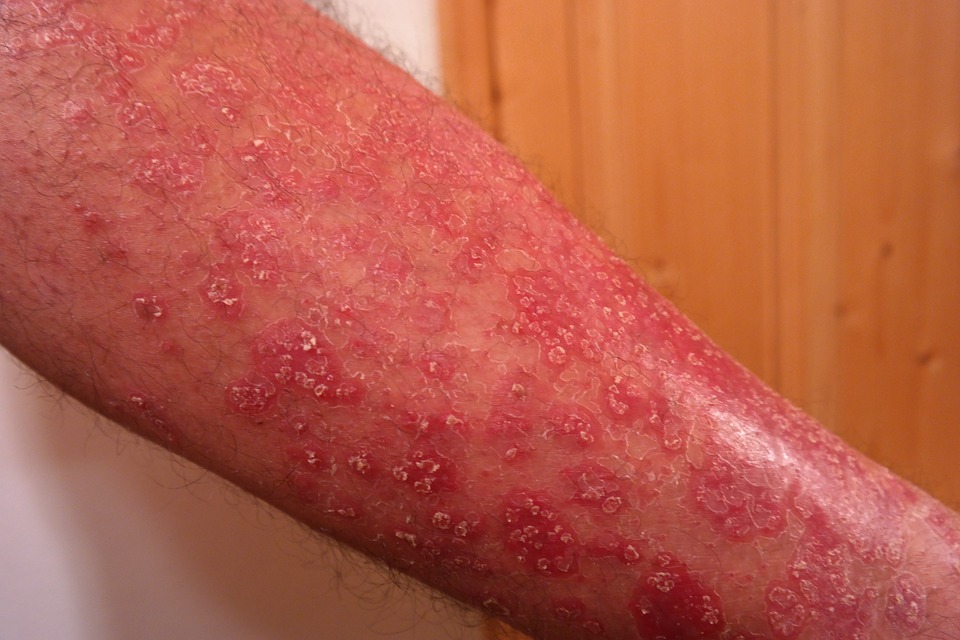If you’re like most Americans, you’ve been alarmed by an unusual rash forming on your skin—seemingly out of nowhere. You may have wondered what in the world caused it. Was there something different about the laundry detergent? Were you bitten by a bug? Did you eat something new?

(Pixabay / Hans)
Most of us experience skin rashes at some point, but pinpointing their cause and treating them appropriately can be a challenge.
Allergy-induced rashes
Many rashes are caused by allergies—here’s a look at the most common ones.
- Hives (also known as urticaria). These raised, red bumps can develop anywhere on the body—even on the tongue, in the ears, or in the throat. They itch and sometimes sting. They can be as small as the tip of your pinky finger or as large as a dinner plate. If you have an acute case of hives, they may go away within several hours. Chronic hives, on the other hand, last for more than six weeks—sometimes stretching out for many months. Even if they do go away, they may recur over the course of years.
- Angioedema. This rash is similar to hives, but it occurs beneath the skin instead of on its surface. It causes the tissues to swell and gives the appearance of hives—very big hives. In fact, angioedema is sometimes called “giant hives.” Angioedema commonly occurs on the face—usually around the eyes and lips—and genitals.
- Atopic dermatitis (also known as eczema). Eczema is characterized by raised, scaly skin patches. They can be very itchy as well as painful. In severe cases, they may crack, ooze, and crust over, sometimes becoming infected. Eczema is most common in children, often manifesting in infancy. It tends to run in families and be more common in people affected by other allergy symptoms (asthma, hay fever, etc.) Roughly two-thirds of kids outgrow eczema, though they may struggle lifelong with dry skin. Though rare, it is possible to get adult-onset eczema. In fact, this condition has been on the rise in recent years.
- Contact dermatitis. This type of rash results from direct contact with an allergenic substance, to include nickel (common in jewelry), fragrances (such as those found in cosmetic items), dye (such as hair dye), and poison ivy. Contact dermatitis can also be triggered by something entering your body, such as medicine or different food flavorings.
Non-allergy triggers
While allergies are responsible for many rashes, there are other offenders:
- Bugs. Bed bugs, fleas and, of course, the dreaded mosquito can leave you covered in red marks before you even realize what has happened. Tick bites can cause redness to develop in a “bullseye” formation (a hallmark of Lyme disease) anywhere from three to 30 days after the bite. Microscopic mites can burrow into your skin and lay eggs, resulting in the highly contagious scabies rash.
- Illness/infection/disease. Measles, chickenpox, and shingles, which is caused by the same virus as chickenpox, all cause rashes. Scarlet fever can cover the body (but not the hands and feet) with tiny red bumps. Fifth disease results in a rash on the cheeks, arms, legs, and upper body while hand-foot-and-mouth-disease causes raised, red spots on the palms of the hand and soles of the feet. Both of these diseases are more common in children than adults. Rosacea, which commonly affects older adults, causes redness and visible blood vessels on the face.
- Fungus—Fungi can thrive on warm, moist body parts that don’t get a lot of ventilation—like the feet or groin. Ringworm and athlete’s foot are common fungal infections that manifest as rashes.
Many rashes will go away as quickly as they came, but others persist. You should see a doctor about your rash if it becomes so uncomfortable that it is making it hard to perform daily duties or sleep at night. You should also see a doctor if your rash lasts beyond a few weeks or if it is particularly painful.
Your doctor can recommend an appropriate treatment. Keep in mind that if the rash is allergy-induced, a topical cream may help—but It will not address the source of the problem. If you struggle with eczema or chronic hives/angioedema, talk to your doctor about allergy immunotherapy, which is the only treatment that has been shown to address the underlying allergy—not just its symptoms.
Allergy immunotherapy is available through allergy shots or under-the-tongue allergy drops (sublingual immunotherapy). Drops have a higher safety profile than shots so they can be taken at home. If you have a young child who suffers from eczema, talk to your doctor about allergy drops for kids. While allergy shots aren’t usually recommended for kids under the age of 7, allergy drops have been shown to be safe for kids under the age of 5.


